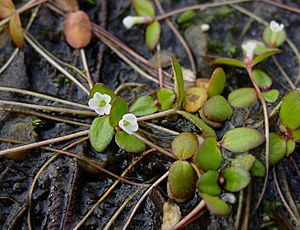Little amphianthus facts for kids
Quick facts for kids Little amphianthus |
|
|---|---|
 |
|
| Conservation status | |
| Scientific classification | |
| Genus: |
Gratiola
|
| Species: |
amphiantha
|
| Synonyms | |
|
Amphianthus pusillus Torr. |
|
Gratiola amphiantha is a very special and rare flowering plant. It's known by fun names like little amphianthus, pool sprite, and snorkelwort. This tiny plant lives in the southeastern United States. It was once in its own group, but scientists used DNA studies to move it into the Gratiola family in 2008.
Contents
Meet the Little Amphianthus
The little amphianthus is a very small plant. It grows in a unique type of habitat. This plant is considered a threatened species by the government. This means it needs special protection to survive.
Where This Rare Plant Lives
This plant is native to the Piedmont region. This area is in the southeastern United States. Most of these plants are found in Georgia. You can also find them in Alabama and South Carolina.
The little amphianthus lives only on granite outcrops. These are large, exposed rocks. They are very special places because many different kinds of plants and animals live there. This makes them high-biodiversity areas.
What the Snorkelwort Looks Like
Gratiola amphiantha is a tiny aquatic plant. This means it lives in water. It grows in temporary pools that form on granite outcrops. These pools are called vernal pools. They fill with water after it rains and then dry up.
The plant is an annual herb. This means it lives for only one growing season. It has a short, thin stem. At the bottom, it has a circle of tiny, thin leaves. These leaves stay underwater. Above them, it has two slightly larger, oval-shaped leaves that float on the water. These floating leaves can be up to 8 millimeters (0.3 inches) long.
The plant has flowers both underwater and on the surface. The underwater flowers do not open. The flowers on the water's surface have five white petals. They are only a few millimeters long.
The Amazing Life Cycle of Pool Sprite
This plant grows very quickly. When there is enough rain, its seeds start to grow right away. It can grow and flower in just 17 days! Its life cycle is so fast because the pools where it lives do not stay wet for long. The plant needs to grow and make seeds before the water dries up.
Not many other plants grow in these vernal pools. A few local plants, like certain types of Isoetes (such as Isoetes piedmontana), can also be found there.
Protecting the Little Amphianthus
Scientists estimate there are about 31 groups of these plants. In wet years, some pools can have thousands of plants. This is good news for the species.
However, the little amphianthus faces some big dangers. Many granite outcrops are being used for quarrying. This means the rock is dug up and removed. This is the biggest threat to the plant. Other dangers include off-road vehicles driving over the habitat. People also sometimes dump trash and other things on the outcrops.
In some places, farm animals like cows graze near the pools. Their waste can cause eutrophication. This means the water gets too many nutrients. This makes the water unhealthy for the plant.
Scientists and conservation groups are working to protect this unique plant and its special habitat.


